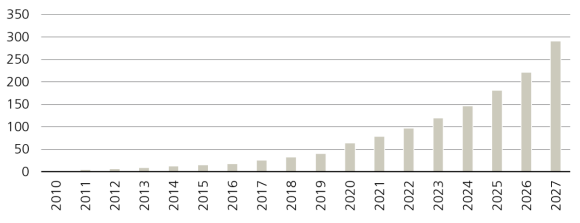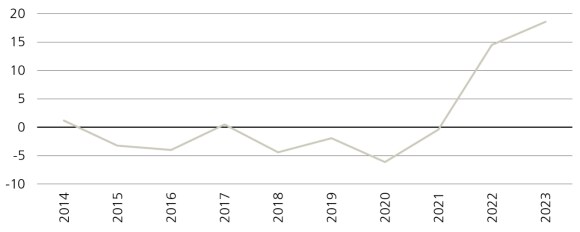AI and real estate investment & data centers
AI's impact on investment performance and opportunities in data centers

AI and real estate investment
AI and real estate investment
Ultimately, real estate values are determined by the income that assets generate, its expected growth trajectory and the discount rate applied to those income streams. The discount rate in turn is determined by market interest rates and the risk premium applied, which in itself relates to the risk and volatility of expected income flows. Properties which generate outsized income growth compared to expectations will tend to generate higher returns than expected. This is what happened to the logistics sector when retail rotated online. This resulted in very strong demand for logistics facilities which drove strong rental growth and pushed valuations sharply higher, and by more than expected. Hence, when assessing real estate investment opportunities which might arise from AI, we should focus on the impact on the overall demand for space from occupiers, the ability of occupiers to pay rents and any impact on the volatility of income flows and risks associated with them. Finally, we also need to consider how responsive supply is.
From another perspective, as AI helps to improve productivity and boost economic growth, some consumers will be subject to a wealth effect. For example, there could be some increased travel and consumer spending, providing a boost to demand for the hospitality and retail sectors. It could also impact the residential sector if households have more income available to spend on rent or mortgage payments. From another perspective, as AI helps to improve productivity and boost economic growth, some consumers will be subject to a wealth effect. For example, there could be some increased travel and consumer spending, providing a boost to demand for the hospitality and retail sectors. It could also impact the residential sector if households have more income available to spend on rent or mortgage payments.
Data centers – the engine room of AI
Data centers – the engine room of AI
Data centers are the engine room of AI and the most obvious investment opportunity arising from the widespread adoption of the technology. As companies incorporate AI into their businesses, they will require more computing power, cloud-based data and data center capacity. As such, data centers and towers present both short-term, potentially higher returning development opportunities, and also longer-term opportunities to acquire stabilized assets.
Data centers were already experiencing a positive growth trend prior to the rapid adoption of AI, but this is now being fueled by the take-up of the technology. For example, the annual datasphere, which measures the amount of new data created globally, is expected to double as soon as 2027 and indicates strong growth in demand for data centers ahead (see Figure 1).
Figure 1: Annual size of global datasphere (2010 to 2027, zettabytes, level values)

Revenue from generative AI software is expected to grow by 58% p.a. from 2023 to 2028 according to S&P Market Intelligence. This growth is driven by computing requirements from cloud service providers and social media platforms; and corporate enterprises across the automotive, financial services, health care and telecoms industries. Cloud service providers present a growing revenue opportunity and are witnessing an acceleration in capital expenditures to reap the rewards of AI.
A reliable, uninterrupted power supply is a key requirement for data center sites. However, AI workloads require significantly more computing power than non-AI applications, and hence can absorb a significant amount of the power available across major data center markets. As such, data center developers and owners need to be able to secure sizable and sustainable sources of power, which can be a constraint on development. As a result, end-users which have large AI workloads may choose newer facilities with more power available.
Limited supply and rising demand have led to falling vacancy rates and are exerting upward pressure on data center rents (see Figure 2). AI and machine learning requirements are drivers of demand and data centers witnessed record levels of take-up in 2023 according to JLL. There were 352 MW of take-up recorded across the core markets in Europe, up 19% YoY. Frankfurt has dominated European take-up, with a third of all demand in the core European markets monitored.
JLL predicts that in 2024, take-up will increase by 15% from the record level seen in 2023 for core European markets, including Frankfurt, Dublin, London, Amsterdam and Paris, with London forecast to see a significant uptick. Will the supply of data centers be able to keep up with growing demand amid the power and planning constraints which restrict data center development? Restrictions in new supply could create favorable demand dynamics and support further rental growth and drive strong investment performance.
Figure 2: North America data center rental growth (2014 to 2023, % YoY)

On the investment transactions side, according to JLL USD 2.34 billion was invested into EMEA data centers in 2023, more than double the USD 0.76 billion in 2022.
Other trends driving data flows include the growing role of cybersecurity, connectivity networks and hardware components. The surge in demand for AI-related hardware and software has had follow-on impacts for materials, labor and real estate. Digital infrastructure networks (5G, mobile and fiber networks) are also experiencing growth.
Want more insights?
Want more insights?
Subscribe to receive the latest private markets perspectives and insights across all sectors directly to your inbox.
Make an inquiry
Fill in an inquiry form and leave your details – we’ll be back in touch.
Introducing our leadership team
Meet the members of the team responsible for UBS Asset Management’s strategic direction.
